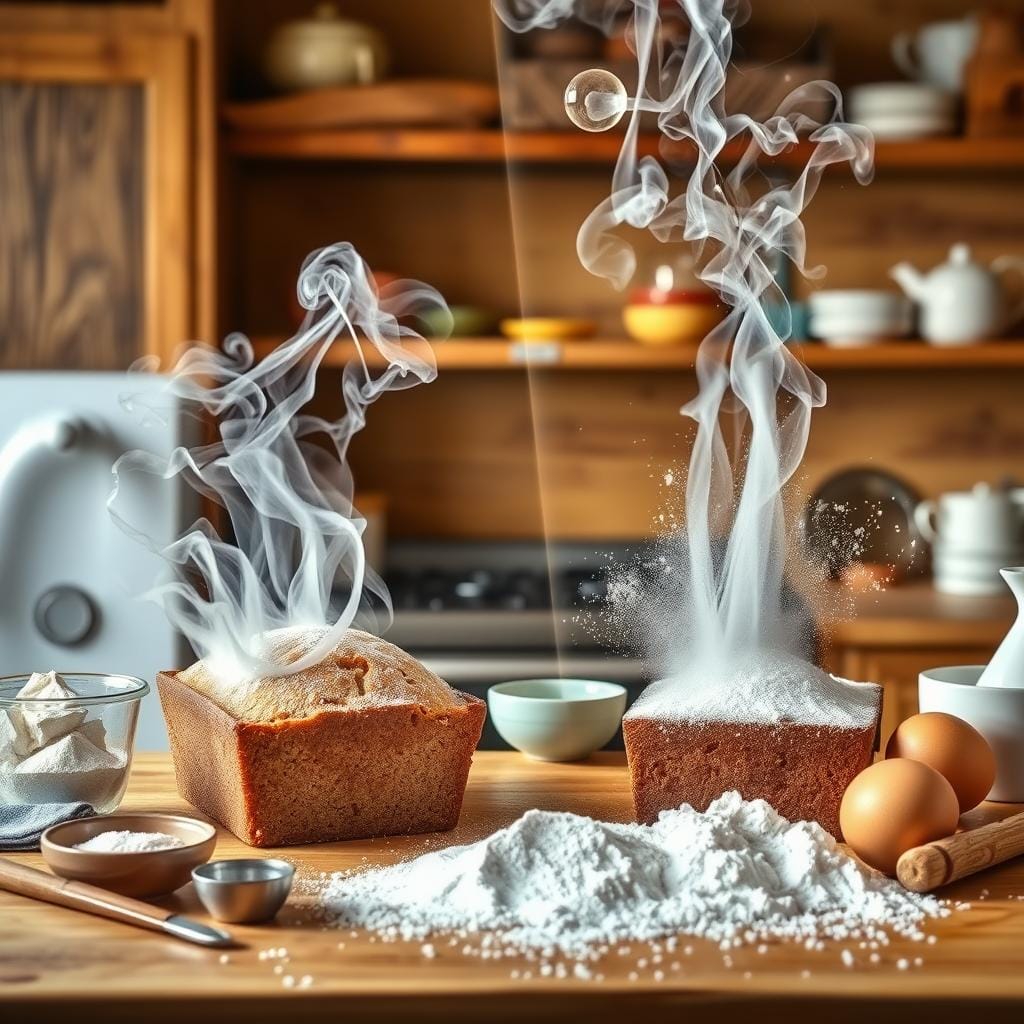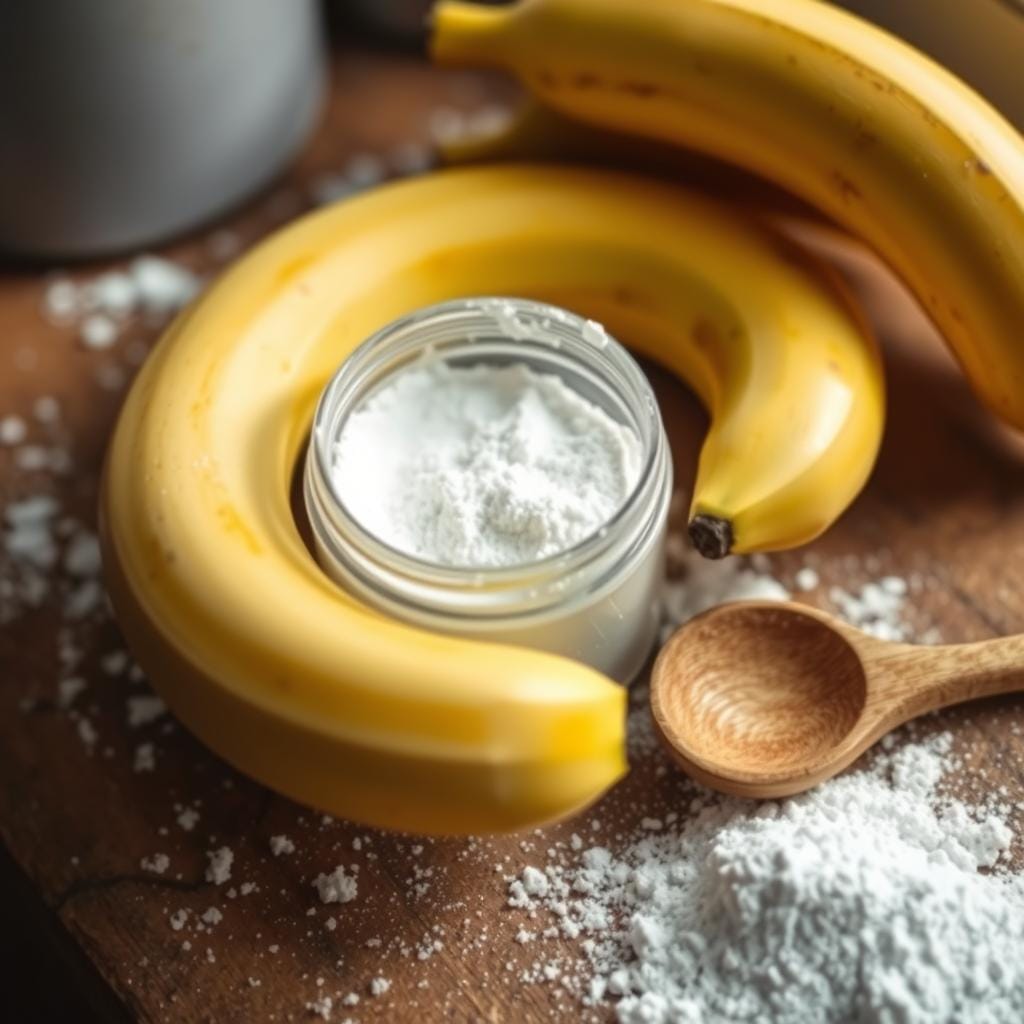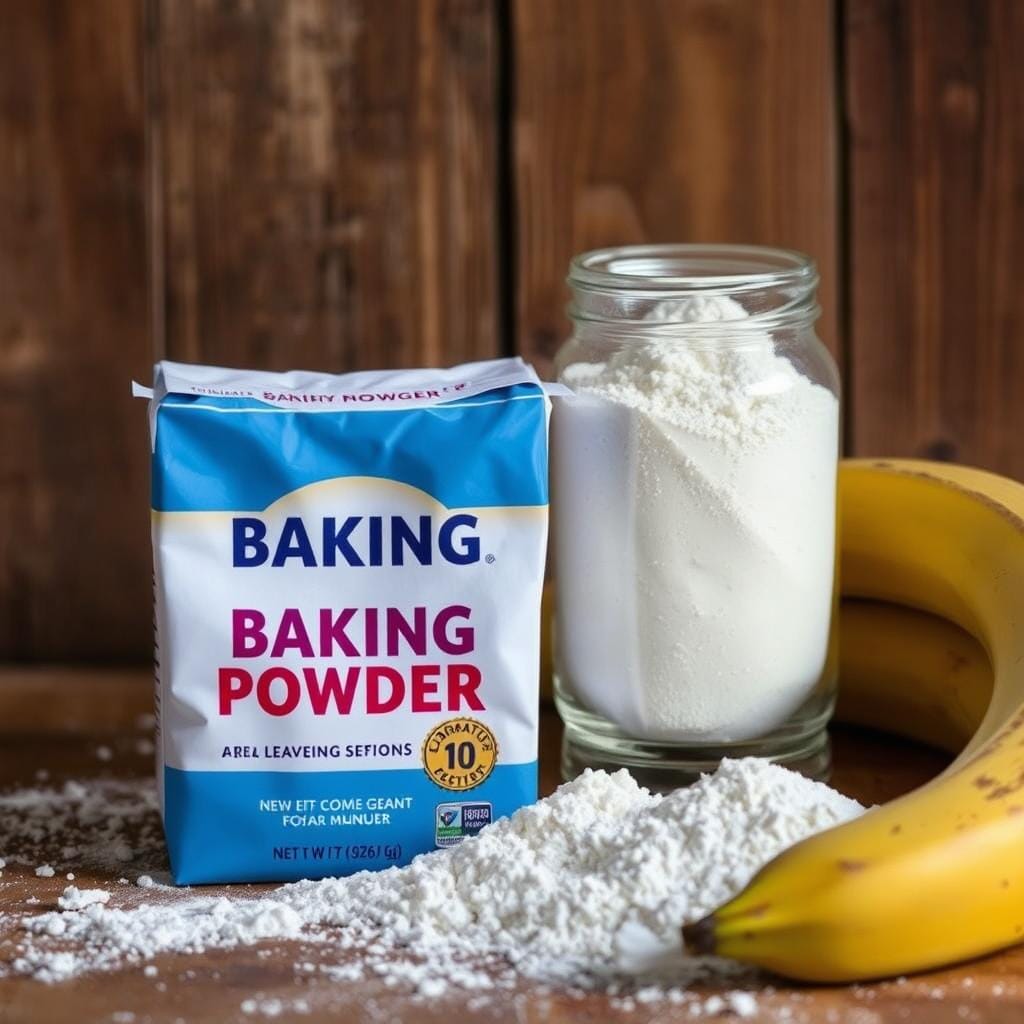I love baking banana bread at home. It’s not just about following a recipe. It’s about understanding the science behind it. Choosing the right leavening agent can make all the difference. Today, we’re going to explore the debate: baking soda or baking powder for the best banana bread?
Key Takeaways
- Understand the chemical differences between baking soda and baking powder and how they impact banana bread texture and rise.
- Explore the specific roles these leavening agents play in quick breads like banana bread.
- Learn how to properly measure and store baking soda and baking powder for optimal results.
- Discover common mistakes to avoid when using these ingredients and how to troubleshoot baking issues.
- Gain insights on when to use baking soda versus baking powder for your banana bread recipe.
Understanding Leavening Agents in Banana Bread
Leavening agents are key in baking banana bread. They make the bread light and airy. Let’s explore how they work and their impact on baking.
Chemical Reactions in Baking
Leavening agents like baking soda and baking powder create carbon dioxide gas. This gas makes the dough expand, giving it a light rise. The chemical reactions are amazing, turning dense batter into a fluffy loaf.
Role of Leaveners in Quick Breads
Quick breads, like banana bread, use chemical leaveners for a fast rise. These agents react quickly with moisture and heat. This fast action helps the bread rise and get its signature texture.
Impact on Texture and Rise
The type and amount of leavening agent affect banana bread’s texture and rise. Finding the right balance is crucial. It ensures the bread is light, airy, and has a tender crumb that matches its sweet flavors.
| Leavening Agent | Effect on Texture | Effect on Rise |
|---|---|---|
| Baking Soda | Produces a more coarse, open crumb | Provides a significant rise, resulting in a taller loaf |
| Baking Powder | Creates a finer, more tender crumb | Produces a moderate rise, resulting in a slightly shorter loaf |
Knowing how leavening agents work in banana bread is key to perfecting it. By understanding these ingredients, you can make your banana bread recipes even better.

The Science Behind Baking Soda in Banana Bread
Baking soda is a key ingredient in banana bread. It helps the bread rise and gives it a great texture. But what makes it work its magic? Let’s explore the science behind baking soda’s role in banana bread.
Baking soda, or sodium bicarbonate, reacts with acidic ingredients like bananas. This reaction creates carbon dioxide gas. The gas forms bubbles in the batter, making the bread rise.
To make baking soda work best, it needs an acidic environment. The bananas in your recipe provide this. When the batter heats up in the oven, the reaction speeds up. This creates more carbon dioxide, making the bread light and fluffy.
| Leavening Agent | Chemical Reaction | Impact on Banana Bread |
|---|---|---|
| Baking Soda | Reacts with acidic ingredients to produce carbon dioxide | Provides a light, airy texture and rise |
Knowing how baking soda works can make your banana bread even better. Finding the right balance of baking soda and acidic ingredients is crucial. This ensures your banana bread turns out perfectly every time.

How Baking Powder Works in Your Recipe
Baking powder is key in many baked goods, like banana bread. But, have you wondered how it works? It’s all about the science behind baking powder and the difference between single and double-acting types.
Single vs Double Acting Baking Powder
Baking powder mixes baking soda, an acid, and a moisture-activated agent. When you add liquid, the baking soda and acid react. This reaction creates carbon dioxide bubbles, making the batter rise.
The main difference between single and double-acting baking powder is when this reaction happens. Single-acting baking powder reacts right when you mix it with wet ingredients. Double-acting baking powder has a two-stage reaction. The first stage is when you mix it with liquid, and the second is when it heats up in the oven.
Double-acting baking powder is better because it ensures your baked goods rise well, even if the mix isn’t perfect.
Proper Measurements and Storage
When using baking powder, being precise is important. Always follow the recipe’s instructions for the right mix. Also, keep baking powder in an airtight container in a cool, dry place to keep it fresh.
| Baking Powder Storage Tips | Shelf Life |
|---|---|
| Store in an airtight container | 6-12 months |
| Keep in a cool, dry place | Sealed: 6-12 months Opened: 3-6 months |
| Avoid humidity and high temperatures | Test for freshness before using |
By knowing how baking powder works and following the right storage and measurement tips, you’ll make perfect banana bread every time.
Should I Use Baking Soda or Baking Powder for Banana Bread?
Choosing between baking soda and baking powder is key to a great banana bread. Both leavening agents are important for the bread’s rise and texture. Knowing their differences can help you pick the right one for your banana bread recipe.
Baking soda works with acidic ingredients like buttermilk or ripe bananas. It creates carbon dioxide bubbles that make the batter rise. Baking powder, on the other hand, is a mix of baking soda and an acid. It can leaven without needing extra acidic ingredients.
Choosing between baking soda and baking powder depends on your recipe and what you want. If your recipe has acidic ingredients, baking soda is a good choice. It reacts well with those ingredients. But if your recipe lacks acidity, baking powder can still make it rise without extra acidity.
| Characteristic | Baking Soda | Baking Powder |
|---|---|---|
| Primary Ingredient | Sodium bicarbonate | Sodium bicarbonate + Acidifying agent |
| Reaction | Requires acidic ingredients | Self-contained reaction |
| Flavor Impact | Slightly metallic taste | Neutral flavor |
| Recommended Use | Recipes with acidic ingredients | Recipes without sufficient acidity |
In the end, the choice between baking soda and baking powder for your banana bread recipe depends on your ingredients and desired texture. Try both to see which one works best for your homemade banana bread.
Common Mistakes When Using Leavening Agents
Baking soda and baking powder are powerful tools in baking. But, they can be tricky if you don’t know how they work. To make sure your banana bread turns out right, avoid these common mistakes.
Over-leavening Issues
Using too much baking soda or baking powder can ruin your banana bread. It might rise too much and then fall, making it dense and gummy. Always follow the recipe’s measurements and don’t add extra leavening agents.
Timing and Temperature Considerations
- Baking soda works fast when mixed with acidic ingredients. Get your batter in the oven quickly to get the best rise.
- Baking powder takes longer to react. Don’t let your batter sit too long before baking, or it will lose its power.
- The right oven temperature is crucial. Bake your banana bread at the correct temperature to prevent it from expanding too much.
Shelf Life and Potency
Baking soda and powder lose their strength over time. Always check their expiration dates and test them before using. Old leaveners won’t help your banana bread rise as it should.
Understanding how to use leavening agents is key to baking success. Focus on the right amounts, timing, and freshness. This way, you’ll always get moist and fluffy banana bread.
Adapting Recipes: When to Use Which Leavener
Baking banana bread can be different depending on whether you use baking soda or baking powder. Knowing how to swap one for the other is crucial. It helps you adjust your banana bread recipe to fit your taste and what ingredients you have.
Baking soda and baking powder both make banana bread light and fluffy. But they work in different ways. The amount you need can change based on your recipe’s other ingredients.
Substituting Baking Soda for Baking Powder
You can swap baking soda for baking powder in banana bread recipes. Use about 1/3 the amount of baking soda as the recipe calls for baking powder. For instance, if it says 1 teaspoon of baking powder, use 1/3 teaspoon of baking soda.
Baking soda needs an acidic ingredient to work. This could be buttermilk or sour cream. If your recipe lacks this, add a bit of lemon juice or vinegar. This ensures the baking soda works right.
Substituting Baking Powder for Baking Soda
Switching baking soda for baking powder is simpler. You can use the same amount of baking powder as the recipe calls for baking soda. So, if it says 1/2 teaspoon of baking soda, use 1/2 teaspoon of baking powder.
Baking powder already has baking soda and an acid in it. So, it doesn’t need extra acidic ingredients. This makes it easy to use when you’re out of baking soda or want to try something new.
| Leavener | Substitution Ratio | Notes |
|---|---|---|
| Baking Soda | 1/3 the amount of baking powder | Requires an acidic ingredient to activate |
| Baking Powder | 1:1 ratio with baking soda | Self-contained leavening agent, no additional acid needed |
The right amount of leavening agent is key for banana bread’s texture and rise. Adjust the amounts carefully and test the recipe to get the results you want.
Impact on Flavor and Browning
Choosing between baking soda or baking powder can change how your banana bread tastes and looks. It’s important to know the science behind these reactions. This knowledge helps you get the perfect taste and look.
Taste Differences Between Leaveners
Baking soda imparts a slightly bitter taste that may be noticeable in baked goods. In contrast, baking powder, which combines baking soda with acidic ingredients, has a more neutral flavor. While baking soda can give banana bread a tangy kick, using baking powder results in a milder taste.
Color Development in Baking
The leavening agent you pick also affects your banana bread’s color. Baking soda, being basic, helps create the brown crust and caramelized flavors. Baking powder, being more neutral, might make the bread paler and less brown.
| Leavening Agent | Flavor Impact | Browning Effect |
|---|---|---|
| Baking Soda | Slightly Bitter or Metallic | Promotes Maillard Reactions for Deeper Browning |
| Baking Powder | Neutral Flavor | Produces Paler, Less Pronounced Browning |
Knowing the differences between baking soda and baking powder helps you choose the right one for your banana bread. This choice depends on the taste and look you want.
Troubleshooting Banana Bread Texture Problems
Baking the perfect banana bread is a delicate task. Texture issues are common for home bakers. Knowing how baking soda and baking powder work is crucial. Let’s look at some common problems and how to fix them.
A dense, gummy crumb is a common issue. It often comes from over-mixing the batter. This creates too much gluten. To avoid this, mix the ingredients gently and stop when they’re just combined.
On the other hand, an overly dry banana bread might come from too much baking soda or baking powder. These can dry out the batter if used too much. Adjust the amounts in your bread making techniques to get the right texture.
A peaked or domed top can also be a problem. It’s often caused by too much baking soda or baking powder. This makes the bread rise too fast. To prevent this, measure the leavening agents carefully and make sure they’re fresh.
| Texture Problem | Possible Cause | Solution |
|---|---|---|
| Dense, gummy crumb | Overmixing | Mix gently until just combined |
| Dry, crumbly texture | Too much baking soda or baking powder | Adjust leavening agent amounts |
| Peaked or domed top | Excess baking soda or baking powder | Measure leavening agents carefully |
Understanding baking chemistry and the role of leavening agents helps. You can fix and improve your banana bread recipe for the perfect texture every time.
Best Practices for Measuring and Storing Leavening Agents
When baking, precision is crucial, especially with baking ingredients like leavening agents. This includes baking soda and baking powder. The right measurement and storage can greatly affect your baking chemistry recipes, like banana bread.
Proper Storage Methods
It’s important to store leavening agents correctly to keep them effective. Keep baking soda and baking powder in airtight containers. Make sure they are away from moisture, heat, and sunlight.
Storing them in the fridge or freezer can extend their life. But, let them come back to room temperature before baking. This ensures they work right in your recipes.
Testing for Freshness
- To check baking soda’s freshness, mix a bit with vinegar in a bowl. If it bubbles a lot, it’s still good.
- For baking powder, mix a teaspoon with hot water in a cup. If it foams right away, it’s active.
If your leavening agents don’t pass these tests, it’s time to get new ones. This ensures your baking chemistry recipes, like banana bread, turn out right.
“Measuring and storing your leavening agents correctly is just as important as following the recipe when it comes to successful baking.”
Conclusion
Choosing between baking soda or baking powder affects your banana bread’s texture and rise. Both are important in quick breads. Knowing their chemical properties and how they mix with other ingredients is crucial for a perfect loaf.
Whether you choose baking soda or baking powder, remember to use the right amounts. Also, store and handle them properly. This way, your banana bread will always be perfect. Try both to see which one you like best and improves your baking.
Learning about leavening agents and their effects on your banana bread is key. This knowledge will help you make the most delicious and attractive banana bread. So, get your ingredients ready, preheat your oven, and let’s start baking!

